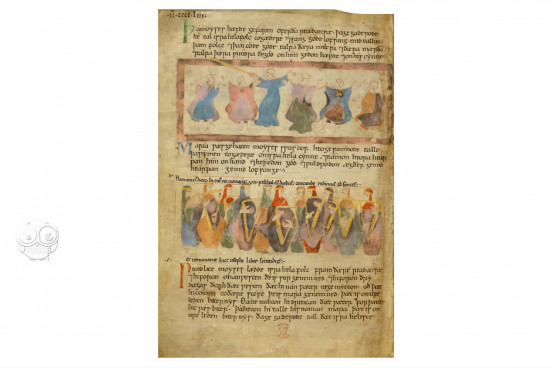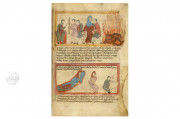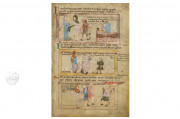Unique among eleventh-century English manuscripts, the Old English Illustrated Hexateuch not only preserves one of the earliest English translations of scripture but also contains hundreds of illustrations drawn directly from the text. The book contains the Old English translation of the biblical books Genesis, Exodus, Leviticus, Numbers, Deuteronomy, and Joshua—all incorporated into Christian scripture from Judaism—as well as Ælfric’s preface to Æthelwærd and excerpts from commentary added as picture captions. The text is written in English Vernacular Minuscule with enlarged single-color capitals introducing new chapters.
There is an informality to the manuscript: the miniatures' framing elements are irregular, and there is a crowded quality to the placement of the pictures in the text. No gold was used, and bright colors are generally reserved for important characters in the scenes with other figures left as pen outlines. The manuscript's illumination is unfinished, and it is impossible to know how fully realized was the artist's vision for the book. Nevertheless, the manuscript's miniatures and Old English text make the Old English Illustrated Hexateuch one of the most important literary and artistic survivals from England before the Norman Conquest.
A New Translation with New Illustrations
The most remarkable aspect of the Old English Illustrated Hexateuch is its extensive program of illumination. The book contains nearly 400 pictures, twelve of which are full-page. The consistent style of the paintings suggests a single artist, although the drawing technique improves considerably from the early pages of Genesis to the beginning of Joshua. The illuminator worked from the translated text and drew literal illustrations rather than copying earlier visual models. Many of the pictures are unfinished, and the various states of completion allow for a nuanced study of the process of illuminating a manuscript. Most illuminations were supplied with Latin captions in the twelfth century and, starting in Exodus, some were touched up in the post-medieval period. Despite this, the scope of the novel project is clear, and the manuscript stands as a testament to the desire for illustrated vernacular texts in eleventh-century England.
Book Production in Canterbury
Several details in the Hexateuch's illustrations indicate that the manuscript was produced in Kent. It has numerous stylistic parallels to the Bayeux Tapestry, especially in the depiction of furniture, ships, and tools. There are also hints of Scandinavian influence, such as in the depictions of Noah's ark with Ringerike-style figureheads with elongated, dragon-like snouts and long, vine-like tongues that wrap around the ship in interlaced knot work.
From Canterbury to Sir Robert Cotton
Immediate and later additions to the Hexateuch indicate that the book remained in use in the early Norman period. A description of the book was recorded in the medieval inventory of Saint Augustine's, Canterbury. The manuscript had already lost its first folio by this time, suggesting that it had not been properly bound. After the dissolution of the monasteries in England, the manuscript was acquired by the antiquarian Robert Talbot. By 1621, it was in the collection of Robert Cotton. It was bequeathed to the British people by Robert's grandson John Cotton and formed part of the British Museum library’s foundational collection in 1753.
We have 1 facsimile edition of the manuscript "Old English Illustrated Hexateuch": The Old English illustrated Hexateuch facsimile edition, published by Rosenkilde and Bagger, 1974
Request Info / Price


